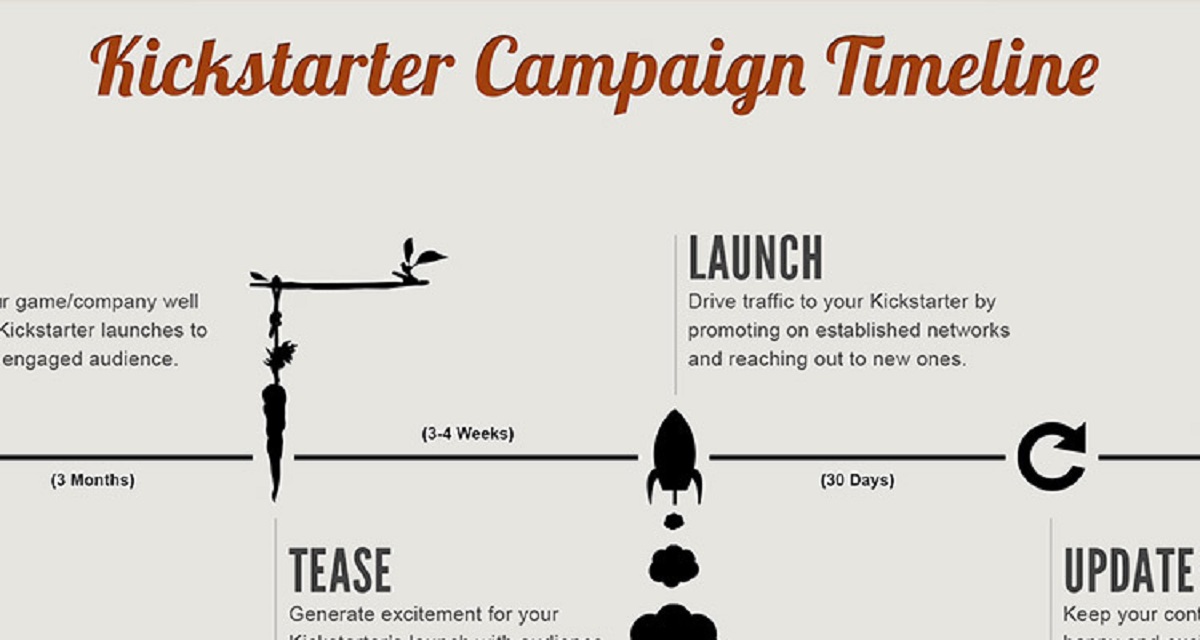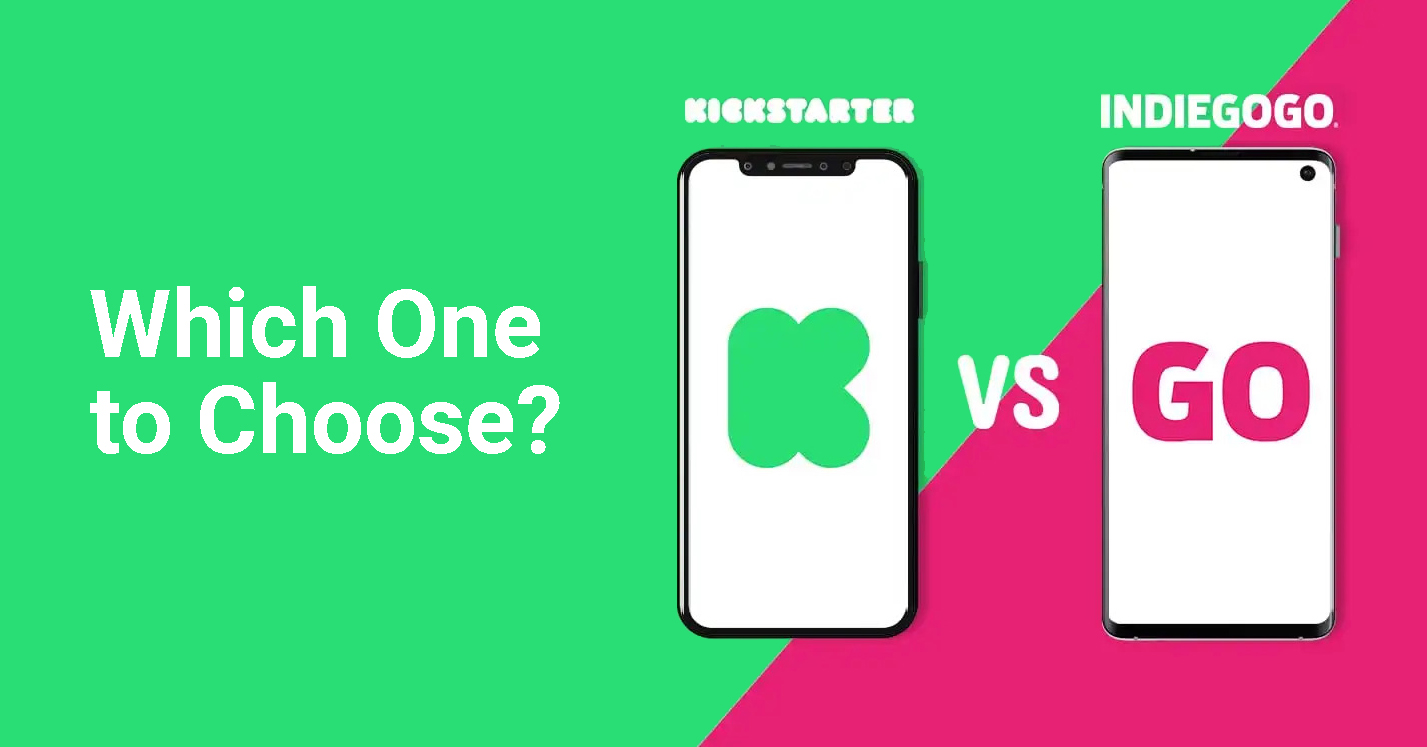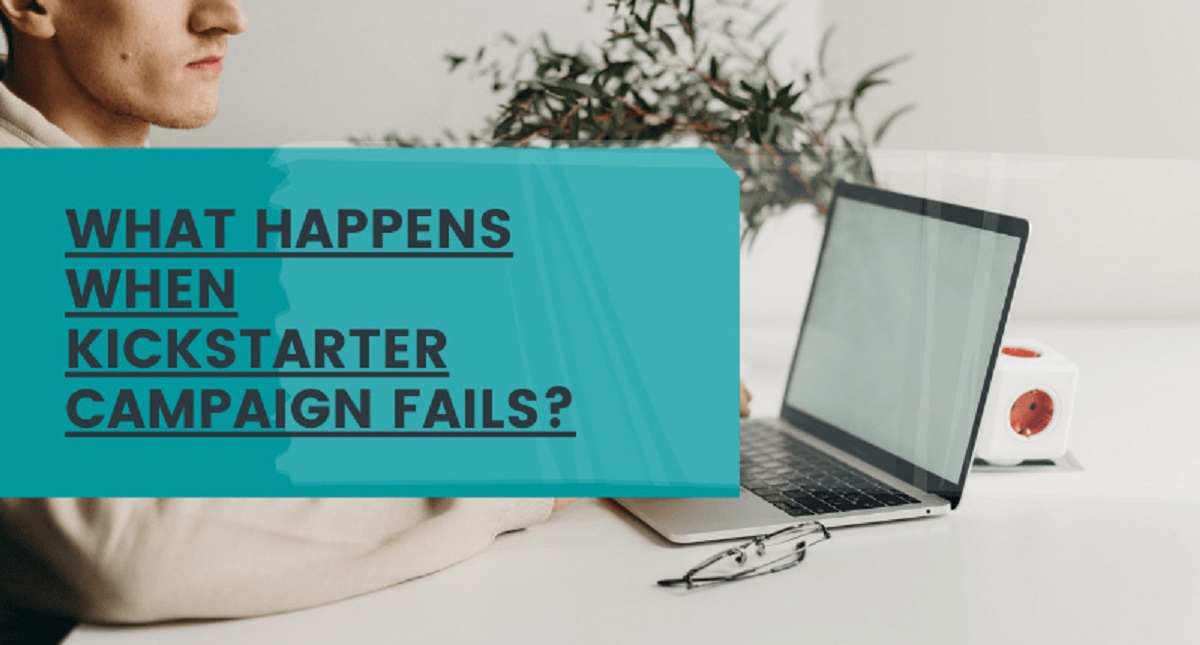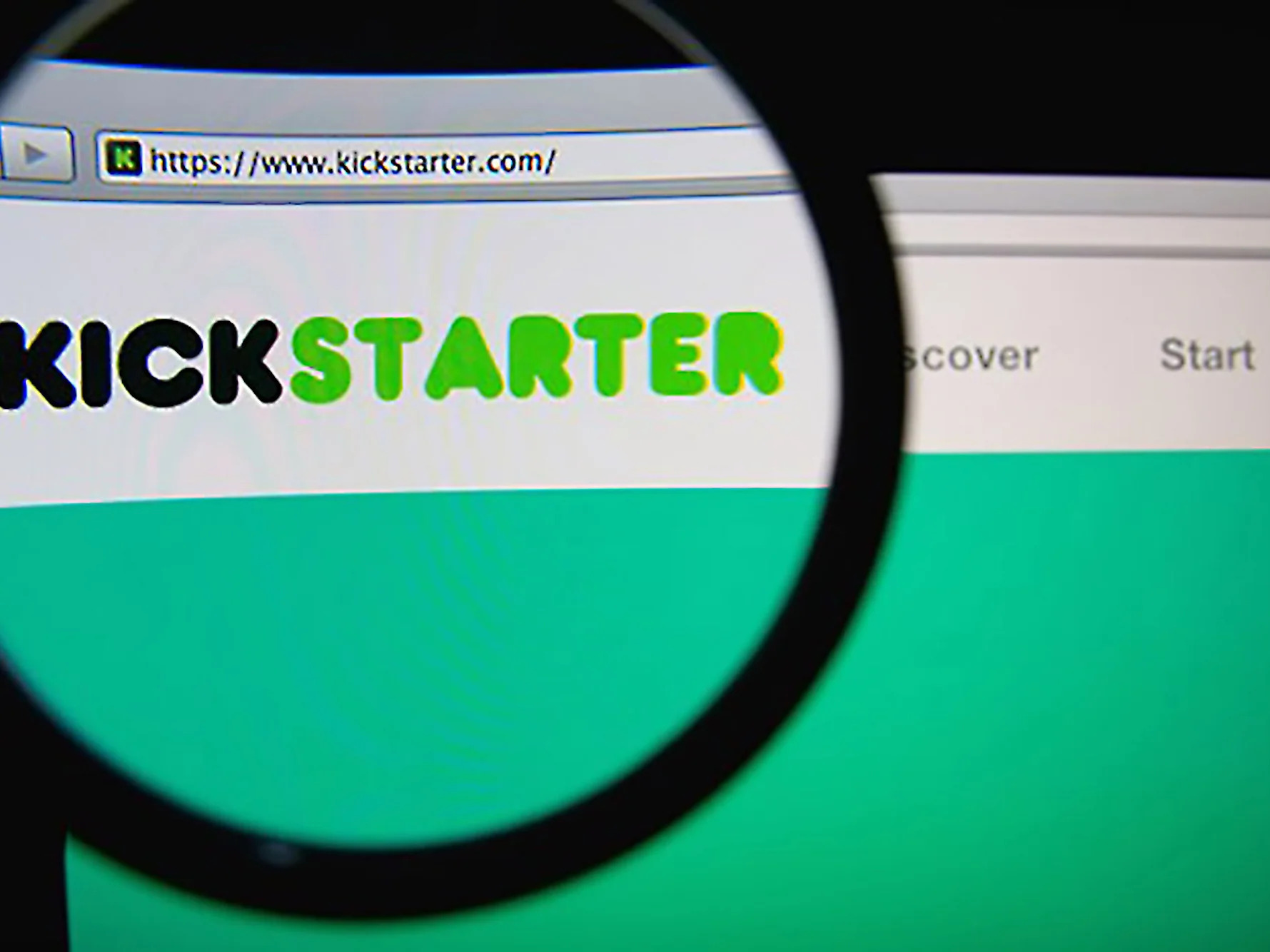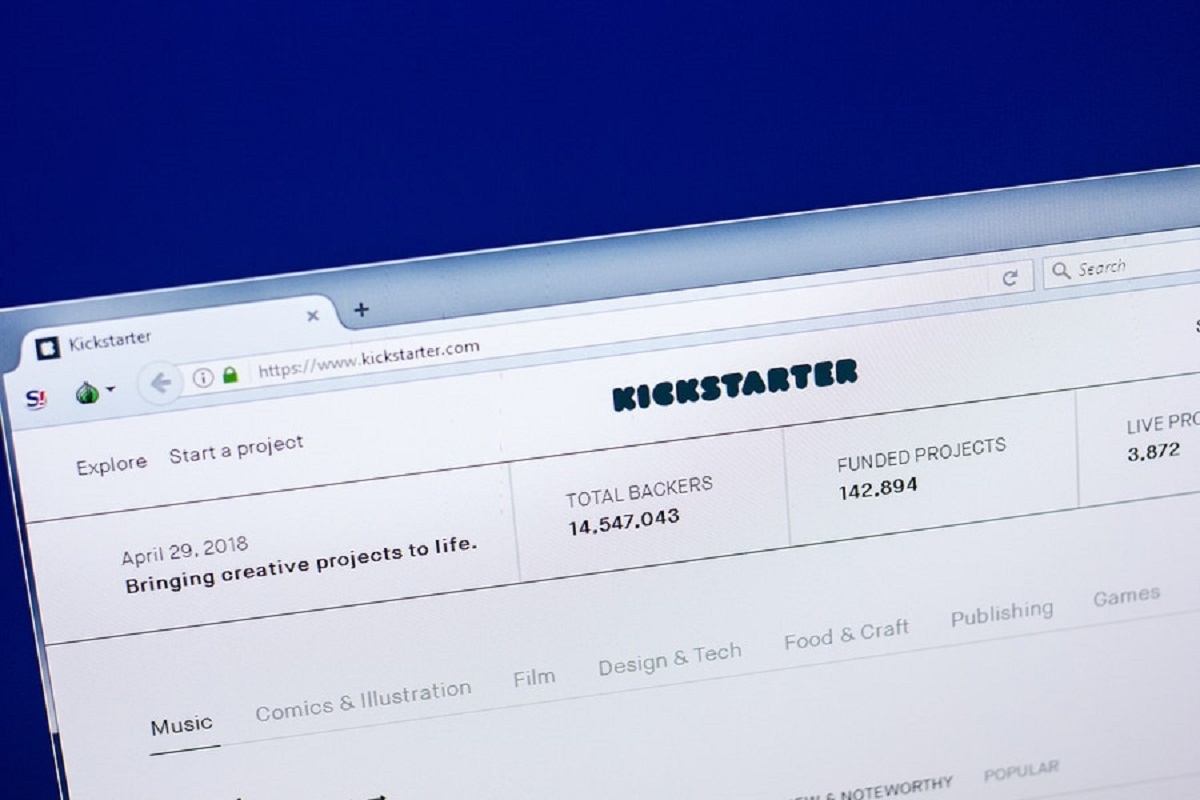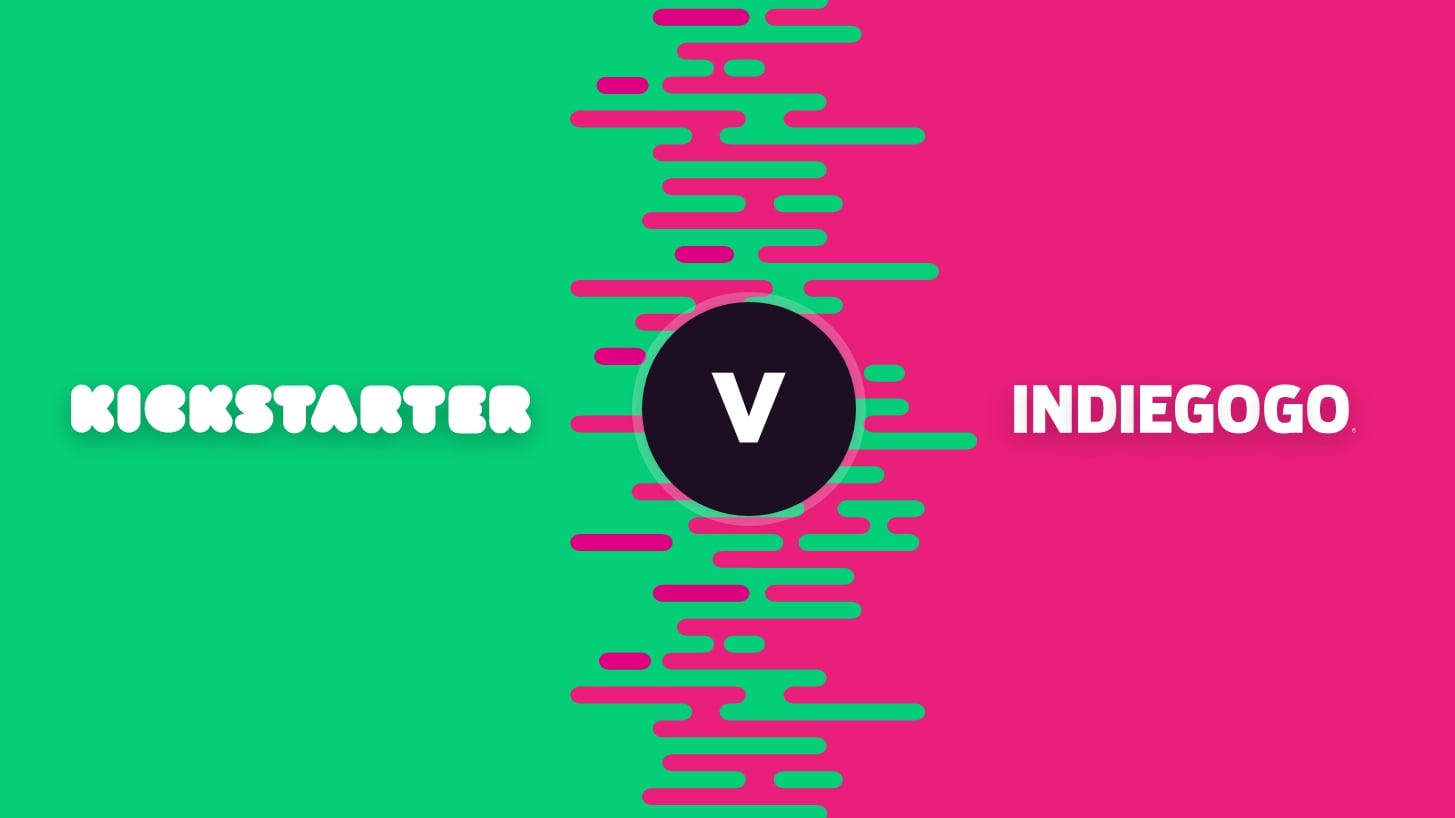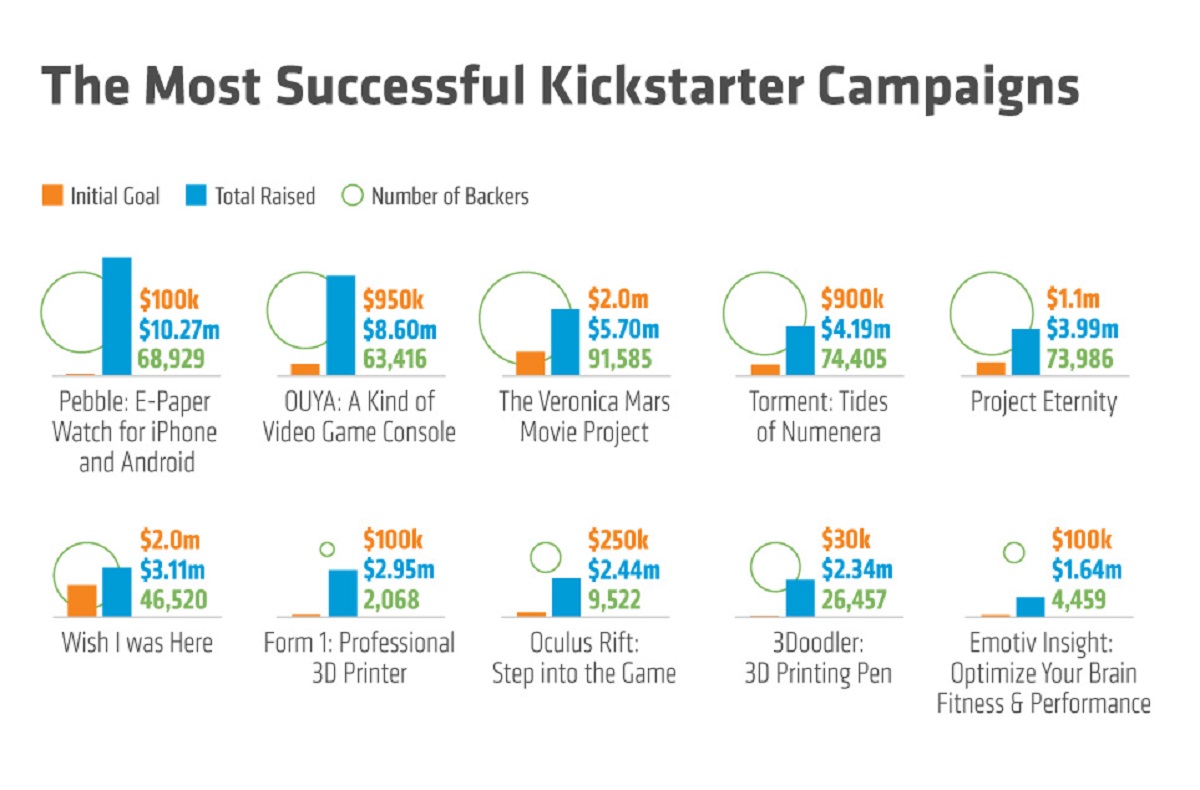Introduction
Welcome to the world of crowdfunding! If you have a brilliant idea that needs funding, Kickstarter is the perfect platform to turn your dreams into reality. With millions of users and a track record of successful projects, Kickstarter has become the go-to destination for creative minds and innovators.
Launching a Kickstarter campaign may seem daunting at first, but with the right strategies and planning, you can increase your chances of success. In this guide, we will walk you through the key steps to launch a successful Kickstarter campaign, from choosing the right project to fulfilling your pledge rewards.
But before we dive into the nitty-gritty details, let’s take a moment to understand the power of Kickstarter. It’s not just a funding platform; it’s a community of passionate individuals who come together to support innovative ideas.
By leveraging Kickstarter, you have the opportunity to connect with your target audience, gain exposure, and receive validation for your project. It’s not just about the money – it’s about building a community around your idea and turning your backers into brand advocates.
Throughout this guide, we’ll provide you with essential tips and insights on how to grab the attention of potential backers, craft a compelling campaign page, set realistic goals, and execute an effective promotional strategy.
Remember, launching a Kickstarter campaign is more than just creating a project page and waiting for the funds to roll in. It requires careful planning, constant communication, and a proactive approach to engage your audience.
So, whether you’re a budding entrepreneur, an artist, a tech enthusiast, or anyone with a passion for making a difference, this guide will equip you with the tools and knowledge to launch a successful Kickstarter campaign and turn your vision into a reality.
Choosing the Right Project
Before you dive into launching a Kickstarter campaign, it’s crucial to choose the right project. The success of your campaign hinges on the viability and attractiveness of your idea. Here are some key factors to consider when selecting your project:
Passion and Expertise: Start by analyzing your own interests and expertise. It’s easier to create a compelling campaign if you’re genuinely passionate about the project. Your passion will shine through in your videos, images, and campaign description, which will resonate with potential backers.
Market Demand: Conduct thorough market research to assess the demand and potential for your project. Is there a need for your product or service? Are there similar projects on Kickstarter that have been successful? Understanding the market landscape will give you valuable insights to determine if your idea is viable.
Feasibility: Evaluate the feasibility of your project in terms of execution, logistics, and budget. Consider the resources and skills required to bring your project to life. It’s crucial to have a realistic assessment of what it will take to deliver on your promises to backers.
Uniqueness: Stand out from the crowd by offering something unique. While competition can be healthy, having a distinct value proposition will make your project more appealing to potential backers. Consider what sets your project apart and how it fulfills a gap in the market.
Scalability: Think about the scalability of your project. Can it be expanded or adapted in the future? Backers appreciate projects that offer long-term potential and growth opportunities.
Achievable Milestones: Break down your project into achievable milestones. Kickstarter backers want to see progress, so having tangible milestones that you can update your audience on will instill confidence and keep backers engaged throughout the campaign.
Emotional Connection: Identify how your project can create an emotional connection with your target audience. Your project should evoke feelings of excitement, curiosity, or a desire to be part of something meaningful. The more emotionally invested your backers are, the more likely they will support your campaign.
Choosing the right project is the crucial first step in launching a Kickstarter campaign. Spend time brainstorming, researching, and refining your ideas until you find the one that aligns with your passion, market demand, and overall feasibility.
Remember, your project will be the foundation upon which your entire campaign is built. So choose wisely and set yourself up for success.
Setting Goals and Planning Your Campaign
Now that you have chosen your project, it’s time to set goals and plan your Kickstarter campaign. A well-planned campaign is more likely to attract backers and achieve success. Here’s how you can go about it:
Define Your Funding Goal: Start by determining the amount of funding you need to bring your project to life. Consider the production costs, manufacturing expenses, marketing budget, and any additional fees or contingencies. Set a realistic funding goal that covers all necessary expenses while ensuring that you can deliver on your promises.
Plan Your Timeline: Create a timeline that outlines the different phases of your campaign, from pre-launch to post-campaign activities. Allocate specific tasks, deadlines, and milestones to keep your campaign on track. This will help you stay organized and ensure that you are proactive throughout the entire process.
Prepare Compelling Campaign Materials: Invest time and effort into creating high-quality campaign materials that showcase your project in the best light. This includes a captivating video, eye-catching images, and a compelling campaign page. Use storytelling techniques to engage your audience and create an emotional connection with your project.
Research and Assess Previous Successful Campaigns: Study other successful Kickstarter campaigns that are similar to yours. Examine their strategies, rewards structure, promotional activities, and engagement with backers. Learn from their successes and incorporate those lessons into your own campaign planning.
Identify and Reach Out to Potential Influencers: Identify influencers, bloggers, YouTubers, and media outlets that align with your project. Reach out to them before launching your campaign to build relationships and discuss potential collaborations. Their support and endorsement can significantly boost your campaign’s visibility and reach.
Create an Engagement and Communication Strategy: Plan how you will engage with your audience and potential backers before, during, and after your campaign. This includes regular updates, responding to comments and messages, and providing transparency about your progress. Building a strong rapport with your backers is crucial for long-term success.
Define Your Rewards Structure: Develop a rewards structure that offers incentives for different pledge levels. Consider offering exclusive rewards, early bird specials, and limited-edition items to encourage backers to contribute more. Your rewards should provide value and reflect the spirit of your project.
Analyze Your Budget and Financial Projections: Evaluate your budget and financial projections to ensure that your funding goal is realistic and achievable. Consider the costs associated with manufacturing, shipping, fulfillment, and any potential taxes or fees. Make sure your pricing and funding goals align with your financial projections.
Test and Optimize Your Campaign Page: Before launching your campaign, conduct thorough testing to optimize your campaign page. Check for any formatting errors, broken links, or confusing sections. Ensure that your content is clear, concise, and visually appealing. A well-designed and user-friendly campaign page will attract more backers.
Planning your Kickstarter campaign is vital for its success. Take the time to set clear goals, create engaging campaign materials, and develop a comprehensive strategy for attracting and engaging with backers. With a well-thought-out plan in place, you are one step closer to launching a successful Kickstarter campaign.
Creating an Engaging Video
When it comes to capturing the attention of potential backers, a compelling video is a must-have for your Kickstarter campaign. A well-crafted video not only explains your project but also sparks emotion, builds trust, and showcases your passion. Here are some key tips for creating an engaging Kickstarter video:
Keep it Concise: Your video should be concise and to the point. Aim for a video length of 2-3 minutes, as shorter videos tend to have higher engagement rates. Grab your audience’s attention from the very beginning and maintain their interest throughout the video.
Tell a Story: Use storytelling techniques to create an emotional connection with your audience. Share the journey, inspiration, and challenges behind your project. Highlight how your project will make a difference or solve a problem. A narrative-driven video is more likely to resonate with viewers and compel them to support your campaign.
Showcase Your Passion: Let your passion and enthusiasm shine through in your video. Be genuine and authentic. When viewers see your dedication and excitement, they are more likely to believe in your project and join you on this journey.
Use High-Quality Visuals: Invest in high-quality visuals, including crisp images, videos, and graphics. Poor visual quality can significantly detract from the impact of your message. Use professional equipment or seek help from a videographer if needed.
Include Testimonials: Incorporate testimonials from early supporters, influencers, or experts in your video. Hearing positive feedback from others can instill trust and credibility in your project. Showcase the impact and value your project has already had on others.
Show Your Prototype or Progress: If you have a working prototype or have made progress on your project, show it in your video. Seeing tangible evidence of your project’s development will build confidence in potential backers, showing them that you have already made significant strides towards bringing your idea to life.
Create a Strong Opening and Closing: Start your video with a captivating hook that grabs attention right away. End with a clear call to action, directing viewers to your Kickstarter campaign page. Make it easy for them to click the “back this project” button and contribute.
Add Captions or Subtitles: Consider adding captions or subtitles to your video. This is especially important for viewers who watch videos without sound or for those who may have hearing impairments. Captions enhance accessibility and ensure that your message is clear to all viewers.
Keep it Professional but Relatable: While it’s important to maintain a professional and polished look, also aim to be relatable. Authenticity and relatability can go a long way in building a connection with your audience. People want to support projects they can personally relate to.
Remember, your video is your chance to make a strong first impression and convince potential backers to invest in your project. Put effort into crafting a compelling and visually appealing video that effectively conveys your project’s story, passion, and unique value proposition.
Crafting a Compelling Campaign Page
Your Kickstarter campaign page is where potential backers go for all the details about your project. It’s essential to create a compelling and informative campaign page that captures attention, builds trust, and convinces people to back your project. Here are some key tips for crafting a compelling campaign page:
Clear and Engaging Project Description: Start with a clear and concise project description that clearly communicates the purpose, features, and benefits of your project. Highlight what makes your project unique and why backers should be excited about it. Use compelling language and storytelling techniques to engage your audience and create an emotional connection.
Eye-Catching Visuals: Incorporate high-quality images and videos that showcase your project in the best possible light. Visuals can have a powerful impact on capturing attention and conveying the essence of your project. Make sure the visuals are relevant and visually appealing, and consider including images that demonstrate the potential impact of your project.
Informative and Scannable Format: Organize your campaign page in a way that is easy to navigate and scan. Use subheadings, bullet points, and short paragraphs to break up the text and make it more digestible. Include key details such as project timeline, manufacturing process, and potential risks or challenges. The information should be presented in a way that is visually appealing and easy to understand.
Highlight Rewards and Stretch Goals: Clearly outline your rewards structure and explain the value backers will receive at each pledge level. Make sure to include enticing and exclusive rewards to motivate backers to contribute more. Additionally, if you have stretch goals, clearly communicate how reaching those goals will enhance the project and its benefits for backers.
Build Trust with Social Proof: Incorporate social proof elements such as testimonials, reviews, and endorsements from early supporters, influencers, or experts in your field. Highlight any media coverage or partnerships you have received. Building trust is crucial for convincing potential backers that your project is credible and worth supporting.
Be Transparent: Transparency is key to building trust and credibility. Be open and honest about the progress of your project, potential risks or challenges, and any changes that may occur during the campaign. Transparency builds confidence in backers and shows that you are committed to delivering on your promises.
Include a Compelling Call to Action: Clearly state what you want potential backers to do – back your project. Use a strong call to action that prompts them to click the “back this project” button and contribute. Make it easy for them to understand how to support your project and highlight any limited-time or exclusive offers to create urgency.
Engage with Backers in the Comments Section: Regularly monitor and respond to comments and questions from backers on your campaign page. Engaging with backers shows that you are actively involved and appreciate their support. Promptly address any concerns or inquiries to maintain a positive and interactive campaign community.
Update Your Campaign Page with Progress: Throughout your campaign, regularly update your campaign page to keep backers informed of any milestones achieved, stretch goals reached, or new developments. This shows your backers that you are committed and actively working on the project, which can inspire further support.
Keep in mind that your campaign page serves as a virtual storefront for your project. Invest time and effort into crafting a compelling and visually appealing campaign page that effectively communicates the value and excitement of your project. With a well-crafted campaign page, you are more likely to attract and convert potential backers into loyal supporters of your project.
Building Buzz and Generating Pre-Launch Interest
Generating pre-launch buzz and interest is crucial for the success of your Kickstarter campaign. Building anticipation and excitement before you even launch can help you gain traction, attract early backers, and create a strong foundation for your campaign. Here are some strategies to build buzz and generate pre-launch interest:
Create a Teaser Campaign: Develop a teaser campaign to generate excitement and curiosity around your upcoming Kickstarter project. This can include sneak peeks, behind-the-scenes footage, or teasers of what’s to come. Use social media, your website, and email newsletters to share these teasers and build anticipation among your audience.
Grow Your Social Media Presence: Build a strong social media presence across platforms that are relevant to your target audience. Share engaging content related to your project’s industry, create anticipation with countdown posts, and engage with your followers through comments and messages. This will help you build a community around your project and increase awareness.
Reach Out to Influencers: Identify influencers, bloggers, journalists, and industry experts who have a following in your niche. Connect with them and share your project details. Offer them early access to your project or exclusive content in exchange for promoting your campaign to their audience. This can significantly expand your reach and credibility.
Offer Early Bird Specials: Create a sense of urgency and reward early supporters by offering exclusive early bird specials. These limited-time offers or discounted prices for the first backers can incentivize people to sign up for notifications or subscribe to your pre-launch email list.
Build an Email List: Create a dedicated landing page or pop-up on your website to capture visitor email addresses. Offer incentives such as exclusive updates or early access to your campaign in exchange for signing up. Use this email list to share updates, build anticipation, and notify subscribers when your campaign goes live.
Host a Pre-Launch Event or Webinar: Consider hosting a pre-launch event or webinar to generate excitement and engage with your audience. This can include Q&A sessions, demos, or interactive discussions about your project. Promote the event through social media, email marketing, and your website to attract potential backers.
Leverage PR and Media Outreach: Craft a compelling press release and reach out to relevant media outlets, journalists, and bloggers to share your story. Be clear about what makes your project unique and how it benefits your target audience. Getting media coverage can significantly boost awareness and generate buzz before your campaign launch.
Create Engaging Content: Develop engaging and shareable content related to your project. This can include blog posts, videos, infographics, or user-generated content. These pieces of content should not only provide value but also generate curiosity and anticipation for your Kickstarter campaign.
Utilize Crowdfunding Communities and Forums: Engage in crowdfunding communities and forums to connect with like-minded individuals and potential backers. Share your project updates, seek feedback, and participate in discussions. Building relationships within the crowdfunding community can help amplify your reach and garner support.
By implementing these strategies, you can effectively build buzz and generate pre-launch interest for your Kickstarter campaign. Creating anticipation, engaging with your target audience, and utilizing various marketing channels will increase the likelihood of a successful launch and set the stage for continued momentum during your campaign.
Setting Your Funding Goal and Rewards
Setting your funding goal and rewards structure are two critical aspects of launching a successful Kickstarter campaign. Your funding goal should be realistic, covering all necessary expenses, while your rewards should entice backers to contribute. Here’s how to set them effectively:
Set a Realistic Funding Goal: Calculate the amount of funding you need to bring your project to life. Consider manufacturing costs, production expenses, marketing budget, and any additional fees or contingencies. It’s crucial to strike a balance between setting an attainable funding goal and ensuring you have enough resources to fulfill your promises to backers.
Research Comparable Projects: Study successful Kickstarter projects in your industry or niche that are similar to yours. Analyze the funding goals they set and the final amounts they received. This research will give you a benchmark to align your own funding goal and provide insights into what’s possible for your project.
Create a Compelling Rewards Structure: Develop a rewards structure that offers enticing incentives for different pledge levels. It’s important to offer a range of rewards to cater to different budget preferences. Consider offering exclusive rewards or limited-edition items that are only available through your Kickstarter campaign. Make sure the value of the rewards aligns with the backer’s investment.
Build Early Bird Specials: Offer exclusive early bird specials for the first backers who support your campaign. Early bird rewards can include discounted prices, limited-edition items, or additional perks. This creates a sense of urgency and rewards backers for their early support.
Consider Stretch Goals: Stretch goals are additional funding targets that, if reached, unlock additional features, enhancements, or rewards. Set stretch goals that are feasible and add value to your project. Stretch goals can incentivize backers to continue supporting your campaign even after the initial funding goal is reached.
Offer Limited Quantity Rewards: Create rewards with limited availability to create a sense of exclusivity and urgency. Limited quantity rewards can be higher-tiered items, personalized experiences, or early access to your project. This encourages backers to act quickly to secure these special rewards.
Keep Shipping and Fulfillment in Mind: Take into account the cost and logistics of shipping and fulfilling the rewards. It’s important to calculate shipping costs accurately when determining the price of your rewards. Consider international shipping options and any potential customs or import duties that may be incurred.
Communicate the Value of Your Rewards: Clearly communicate the value and uniqueness of your rewards in your campaign materials. Use compelling descriptions, images, and videos to showcase the rewards and how they align with the project. Help potential backers understand the benefits and excitement they will receive by pledging to your campaign.
Seek Feedback from Potential Backers: Before finalizing your rewards structure, seek feedback from potential backers or your target audience. This can be done through surveys or focus groups. Listen to their preferences and assess the perceived value of the rewards. Incorporating their feedback can increase the appeal of your rewards and help optimize your campaign.
Remember, your funding goal and rewards structure should be carefully considered to maximize your chances of success. A realistic funding goal, combined with a compelling rewards structure, can drive excitement, attract backers, and motivate them to contribute to your Kickstarter campaign.
Launching Your Kickstarter Campaign
The time has finally come to launch your Kickstarter campaign and bring your project to the world. A successful launch can set the tone for the rest of your campaign and determine its ultimate outcome. Here are some key steps to effectively launch your Kickstarter campaign:
Choose the Right Day and Time: Timing is critical when it comes to launching your campaign. Research shows that launching on a Tuesday, Wednesday, or Thursday tends to be more successful than other days of the week. Consider your target audience’s behavior and schedule when selecting the launch day and time.
Create a Strong Campaign Title and Description: Craft a compelling campaign title and description that conveys the essence of your project in a clear and concise manner. Use keywords that are relevant to your project niche to enhance your visibility in search results. Make sure the description highlights the value and benefits backers will receive by supporting your project.
Promote Your Launch: Spread the word about your campaign launch through various marketing channels. Utilize social media, email marketing, your website, and any relevant communities or forums to announce the launch of your Kickstarter campaign. Generate excitement and encourage others to share the news with their networks.
Share High-Quality Visuals: Accompany your launch announcement with high-quality visuals that showcase your project and its potential. Images and videos play a crucial role in capturing attention and sparking interest. Make sure the visuals accurately represent your project and convey its unique selling points.
Engage with Your Audience: Be prepared to actively engage with potential backers immediately after launching your campaign. Respond promptly to comments, questions, and messages on your campaign page and across social media platforms. Engaging with your audience fosters a sense of community and helps build trust.
Send Personalized Outreach: Reach out to friends, family, and close contacts individually to personally request their support. Consider sending personalized messages or making phone calls to explain the importance of their contribution and how it will help your project succeed. Personalized outreach can increase the likelihood of getting early support.
Offer Early Bird Specials: Incentivize early support by offering exclusive rewards or discounted prices to the first backers. Early bird specials create a sense of urgency and motivate people to contribute right away. Highlight the limited availability of these offers to encourage immediate action.
Keep Momentum Going: Launch day is just the beginning. Continuously promote your campaign throughout its duration to maintain momentum. Regularly share updates, news, and progress with your backers and potential supporters. Engage in conversations, address concerns, and provide transparency to keep your audience excited and engaged.
Monitor and Adjust: Monitor the performance of your campaign during the initial days after launch. Analyze essential metrics like the number of backers, funding progress, and traffic sources. Assess the effectiveness of your marketing efforts and adjust your strategy accordingly. Keep experimenting with different promotional tactics to maximize your campaign’s reach and impact.
Express Gratitude: Show appreciation to your backers through regular updates and personalized thank-you messages. Make them feel valued and part of your project’s success. Expressing gratitude not only strengthens your relationship with backers but also encourages them to spread positive word-of-mouth about your campaign.
Launching your Kickstarter campaign is an exciting milestone in your journey. By carefully planning your launch, utilizing effective marketing strategies, and staying engaged with your audience, you can make a strong and impactful entry into the crowdfunding space.
Promoting Your Campaign
Promoting your Kickstarter campaign is crucial to reach a wider audience, attract more backers, and increase the chances of meeting and surpassing your funding goals. Here are some effective strategies to promote your campaign:
Utilize Social Media: Leverage the power of social media platforms such as Facebook, Instagram, Twitter, LinkedIn, and YouTube to promote your campaign. Create engaging content related to your project, share updates, behind-the-scenes footage, and teasers. Encourage your backers to share your posts and use relevant hashtags to reach a broader audience.
Engage with Influencers and Bloggers: Identify influencers, bloggers, and industry experts in your niche who have a significant following and engage with them. Form partnerships, collaborate on content, or request them to share your campaign with their audience. Their endorsement and support can greatly amplify your reach and credibility.
Optimize Your Campaign Page for SEO: Apply search engine optimization (SEO) techniques to your campaign page to improve its visibility in search engine results. Use relevant keywords in your campaign title, description, and body text. Additionally, include alt tags in your images and meta tags in your HTML code to further enhance SEO.
Reach Out to Your Network: Tap into your personal and professional network to spread the word about your campaign. Send personalized messages or make phone calls to friends, family, colleagues, and acquaintances explaining the importance of their support. Encourage them to share the campaign on their own social media platforms, increasing its visibility.
Create Engaging Content: Develop and share compelling content related to your project. This can include blog posts, videos, infographics, or live streams. Focus on providing valuable information, sharing project updates, and telling stories that resonate with your target audience. Promote this content across different channels to drive traffic to your campaign.
Guest Blogging and Media Outreach: Write guest blog posts for websites or publications in your industry or niche. Offer to share your project story or expertise and include a link to your campaign page. Additionally, reach out to relevant media outlets, journalists, and podcast hosts to pitch your story and secure media coverage.
Run Paid Advertising: Consider running paid advertising campaigns on platforms such as Facebook Ads, Google Ads, or Instagram Ads. Fine-tune your targeting parameters to reach your ideal audience. Monitor the performance of your ads and adjust your targeting and messaging based on the results to optimize your ad spend.
Engage in Crowdfunding Communities: Participate in crowdfunding communities and forums to connect with other campaigners and potential backers. Share your project updates, seek feedback, and engage in discussions. Building relationships within the community can lead to cross-promotion opportunities and word-of-mouth recommendations.
Offer Referral Incentives: Encourage your backers to refer others to your campaign by offering referral incentives. This can include additional rewards, exclusive content, or discounts on future purchases. Providing incentives to your backers for spreading the word can help create a viral effect and expand your campaign’s reach.
Collaborate with Complementary Projects: Identify projects that have a similar target audience or compliment your project in some way. Collaborate with these projects to cross-promote each other’s campaigns. This can extend your reach to a new audience who may be interested in supporting similar projects.
Remember, promoting your Kickstarter campaign requires a proactive and strategic approach. Continuously seek new opportunities, engage with your audience, and adapt your promotional tactics based on data and feedback. By implementing a comprehensive promotion plan, you can maximize the visibility and success of your Kickstarter campaign.
Updates and Communication with Backers
Communication with your backers is crucial for maintaining their support, building trust, and keeping them engaged throughout your Kickstarter campaign. Regular updates and timely responses to their inquiries can make a significant difference in the success of your project. Here are some key strategies for effective updates and communication:
Provide Regular Updates: Keep your backers informed about the progress of your project through regular updates. Share important milestones, production updates, and any challenges you may be facing. Updates foster transparency and build confidence among your backers that you are actively working on delivering a successful project.
Be Transparent and Honest: Openly address any setbacks or delays that may arise during the course of your project. Share the reasons behind the delays and your plan to overcome them. Honesty and transparency foster trust and show your commitment to delivering on your promises.
Use Multiple Communication Channels: Utilize various communication channels to reach your backers effectively. This can include email updates, Kickstarter’s update feature, social media posts, and live streams. Make sure to communicate through channels that you know your backers are actively engaged with.
Ask for Feedback and Input: Engage your backers by seeking their opinions and input on certain aspects of your project. This can include design choices, color options, or additional features. Involving backers in the decision-making process makes them feel valued and strengthens their connection to your project.
Respond Promptly to Backer Inquiries: Be responsive to questions, comments, and messages from your backers. Promptly address their concerns and inquiries, whether through public comments or private messages. Timely responses show that you value their support and are attentive to their needs.
Show Gratitude and Appreciation: Express your gratitude to your backers for their support. Regularly thank them in updates, personalized messages, or even through public acknowledgments. Make them feel part of your project’s success and show that their contribution is valued.
Personalize Communication: Whenever possible, personalize your communication with backers. Address them by name and reference their specific pledges or contributions. Personalization adds a human touch and demonstrates your genuine appreciation for their support.
Engage in Backer-Exclusive Activities: Offer backer-exclusive activities or perks to further engage and reward your supporters. This can include behind-the-scenes access, early access to project updates, or exclusive merchandise. These activities serve as incentives for continued support and build a sense of exclusivity among your backers.
Share User-Generated Content: Highlight and share user-generated content related to your project. This can include testimonials, reviews, or photos of backers enjoying your product or using your service. User-generated content adds credibility and validates your project’s value to potential backers.
Encourage Backer Involvement: Invite backers to share their experiences, thoughts, or suggestions about your project. Create avenues for them to actively participate, such as surveys, polls, or contests. Engaging backers in this way makes them feel like part of your project’s journey and can ignite valuable discussions.
Effective communication with your backers is essential for maintaining their support and fostering a sense of community around your project. By providing regular updates, being transparent, engaging in meaningful conversations, and showing appreciation, you can build lasting relationships with your backers and ensure the success of your Kickstarter campaign.
Navigating Challenges and Obstacles
Launching and running a Kickstarter campaign is not without its challenges. From production delays to unexpected setbacks, navigating these obstacles is crucial to the success of your project. Here are some strategies to help you overcome challenges and obstacles during your Kickstarter campaign:
Anticipate and Plan for Risks: Prioritize risk assessment and planning before launching your campaign. Identify potential challenges, bottlenecks, or obstacles that may arise during the project’s execution. Prepare contingency plans and alternative strategies to mitigate risks and stay on track.
Communicate Transparently: When facing challenges or obstacles, be transparent and communicate openly with your backers. Share updates about any complications or setbacks that may affect your project. Stay proactive in addressing concerns and be honest about the steps you’re taking to overcome difficulties.
Adapt and Adjust: Flexibility is key when navigating obstacles. Be prepared to adapt your plans and adjust your timelines or goals based on the circumstances. Embrace feedback and input from your backers and stakeholders, and be willing to make necessary changes to ensure the ultimate success of your project.
Engage Your Community: Lean on the support of your backers and community when facing challenges. Communicate with them regularly, seek their input and feedback, and involve them in the problem-solving process. Rallying your community around your project can provide valuable ideas, resources, and encouragement to help overcome obstacles.
Seek External Expertise: Don’t hesitate to reach out for external expertise when faced with a particularly challenging obstacle. Connect with mentors, industry experts, or consultants who can offer insights and guidance. Their experience and knowledge can provide valuable perspectives and help you navigate through difficult situations.
Stay Resilient and Motivated: It’s natural to face moments of doubt or frustration when challenges arise. However, it’s important to stay resilient and motivated. Remember your initial passion and vision for the project and use it as fuel to persevere. Seek support from your team, friends, and family to stay focused and determined.
Break Challenges into Relatable Tasks: When faced with overwhelming challenges, break them down into smaller, actionable tasks. Prioritize them and tackle them one step at a time. By dividing the challenge into manageable parts, you can make progress and maintain momentum in moving forward.
Learn and Grow: View challenges and obstacles as opportunities for growth and learning. Embrace them as valuable experiences that can strengthen your project and your ability to navigate future endeavors. Reflect on the lessons learned and apply them to improve your project management skills and decision-making abilities.
Stay Positive and Focus on Solutions: Maintain a positive mindset and focus on finding solutions rather than dwelling on the challenges. Approach obstacles with a problem-solving mentality, seeking creative and innovative ways to overcome them. Positive energy and a solution-focused mindset can make a significant difference in overcoming obstacles.
Remember, challenges and obstacles are a natural part of any Kickstarter campaign. By embracing them as opportunities for growth, maintaining strong communication, seeking support, and staying resilient, you can navigate through these challenges and overcome any obstacles that come your way.
Fulfilling Your Pledge Rewards
Fulfilling your pledge rewards is a critical step towards delivering on your promises and maintaining the trust of your backers. It involves efficiently managing logistics, production, and shipping to ensure that your backers receive their rewards in a timely manner. Here’s how to successfully fulfill your pledge rewards:
Organize and Track Backer Information: Maintain a well-organized database or spreadsheet that includes all relevant backer information, such as names, addresses, and reward selections. This will help you keep track of who receives which rewards and ensure accurate delivery.
Regularly Communicate and Provide Updates: Keep your backers informed about the fulfillment process through regular updates. Notify them of any production or shipping delays, as transparency builds trust and manages expectations. Regular communication reassures your backers that progress is being made and their rewards will be delivered.
Produce Rewards with Quality in Mind: Ensure that the production of your rewards aligns with the quality expectations set in your campaign. Use high-quality materials and work with reliable manufacturers or suppliers. Maintain clear communication with your production partners to ensure that the final products meet your standards.
Quality Control and Inspection: Before shipping the rewards, conduct thorough quality control checks to ensure that each item meets your standards. Inspect for any defects, whether in packaging or the actual product. This ensures that your backers receive items that are in excellent condition.
Packaging and Shipping: Carefully package your rewards to protect them during shipping. Use appropriate packaging materials to prevent damage during transit. Consider special packaging or branding that aligns with the identity and visual aesthetics of your project.
Choose Reliable Shipping Methods: Select reputable shipping providers that offer reliable and trackable services. Consider factors such as cost, speed, and international shipping options. Provide tracking numbers to your backers so they can monitor the progress of their rewards.
Address International Shipping Challenges: International shipping can present additional challenges. Research and understand the customs regulations, duties, and taxes specific to each country you will be shipping to. Communicate these potential charges clearly to your international backers to avoid any surprises.
Respond to Backer Inquiries: Promptly respond to any inquiries or concerns from your backers regarding the fulfillment of their rewards. Be proactive in addressing issues and providing solutions. Keeping open lines of communication demonstrates your commitment to ensuring their satisfaction.
Consider Backer Surveys: Send out backer surveys before initiating the fulfillment process. This allows backers to confirm their reward selections, provide shipping addresses, and communicate any additional preferences or requirements. Surveys help ensure accurate fulfillment and minimize errors.
Track and Confirm Delivery: Keep track of the status of each reward shipment and confirm delivery whenever possible. Follow up with backers who may not have received their rewards and work to resolve any delivery issues. This demonstrates your commitment to ensuring that every backer receives their reward.
Provide Exceptional Customer Service: Offer exceptional customer service throughout the fulfillment process. Respond promptly to inquiries, address concerns, and resolve issues in a timely and professional manner. Positive customer experiences lead to satisfied backers and potential referrals.
Successfully fulfilling your pledge rewards is essential for maintaining a positive reputation and securing future support. By prioritizing organization, communication, quality control, and exceptional customer service, you can effectively fulfill your pledge rewards and leave a lasting positive impression on your backers.
Post-Campaign Follow Up and Thanking Backers
Your Kickstarter campaign doesn’t end when the funding period does. It’s important to follow up with your backers and express your gratitude for their support. Post-campaign follow-up and thanking backers play a crucial role in maintaining strong relationships and fostering a community around your project. Here’s how to effectively carry out this important step:
Send Personalized Thank-You Messages: Reach out to each backer individually to express your heartfelt appreciation for their support. Personalize your messages by addressing them by name and mentioning their specific pledge or contribution. Let them know how important their support was in bringing the project to life.
Highlight the Project’s Achievements: Share a campaign wrap-up update that showcases the accomplishments and milestones reached during the campaign. Reiterate the impact their support had in making these achievements possible. By highlighting the project’s success, you reinforce the importance and value of their contribution.
Provide Post-Campaign Updates: Continue to provide regular updates on the progress of your project even after the funding period. Keep your backers informed about any developments, challenges, or exciting milestones you encounter along the way. This keeps them engaged and involved in the project even after the campaign has officially ended.
Showcase Backer Recognition: Publicly acknowledge and recognize your backers for their support. Consider featuring their names on your project website, in project credits, or through personalized social media shoutouts. Recognizing their contribution publicly demonstrates your gratitude and gives them a sense of pride and involvement in your project.
Offer Backer-Exclusive Benefits: Consider providing exclusive benefits or perks for your backers as a way to show appreciation. This can include early access to project updates, special discounts for future purchases, or access to limited-edition merchandise. Backer-exclusive benefits help foster a sense of loyalty and encourage continued support.
Solicit Feedback and Encourage Reviews: Encourage your backers to provide feedback on their experience with your project. Solicit reviews and testimonials that you can use for future marketing efforts. Their feedback and reviews not only serve as valuable insights for your project but also provide social proof for potential backers.
Stay Engaged on Social Media: Maintain a presence on social media platforms, continuing to engage with your backers and share updates about your project’s progress. Respond to comments, messages, and inquiries promptly. Staying engaged on social media helps to foster an ongoing relationship with your backers and keeps them excited about the project.
Invite Backers to Join Your Project Community: Encourage your backers to join a dedicated community or newsletter where they can stay connected and continue to be a part of your project journey. This can be a platform where you regularly share updates, exclusive content, or behind-the-scenes insights. Creating a community builds a strong support network and keeps backers engaged.
Express Genuine Appreciation: Throughout your post-campaign follow-up, convey genuine appreciation for your backers’ support. Let them know that their contribution made a significant impact and that you value their support and trust. Demonstrating your heartfelt gratitude reinforces the positive relationship you have built with your backers.
Post-campaign follow-up and thanking backers is an essential part of the Kickstarter experience. By taking the time to express gratitude, provide updates, and maintain engagement, you can build strong relationships with your backers, foster a supportive community, and potentially secure future support for your projects.
Conclusion
Launching a Kickstarter campaign can be an exhilarating and challenging journey. From choosing the right project to fulfilling pledge rewards, each step requires careful planning, effective communication, and strategic promotion. By following the tips and strategies outlined in this guide, you can increase your chances of success and create a memorable experience for your backers.
Remember, the key to a successful Kickstarter campaign lies in building a strong community of supporters who believe in your project and vision. Engage with your audience, listen to their feedback, and keep them updated throughout the entire process. By fostering trust, transparency, and open communication, you can foster long-lasting relationships with your backers that extend beyond your Kickstarter campaign.
Additionally, don’t forget to promote your campaign strategically. Utilize social media, reach out to influencers, and leverage crowdfunding communities to expand your reach and attract potential backers. Engaging with your community and getting them excited about your project is crucial for driving momentum and reaching your funding goals.
As you navigate challenges and obstacles along the way, stay resilient, adaptable, and focused on finding solutions. Embrace the learning experiences and growth opportunities that arise, as they will only make you stronger and more prepared for future endeavors.
Finally, always express genuine appreciation and gratitude towards your backers. Their support is what fuels your project and brings it to life. Whether through personalized thank-you messages, exclusive benefits, or ongoing updates and engagement, make sure they know how much their contribution means to you.
Launching a Kickstarter campaign is an incredible opportunity to turn your ideas into reality and connect with a passionate community. With careful planning, effective promotion, and strong communication, you can maximize your chances of success and create a campaign that leaves a lasting impact. So go forth, be bold, and bring your vision to life through Kickstarter.







